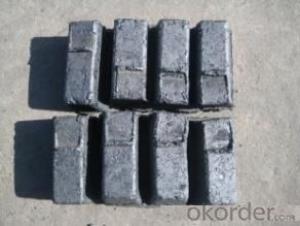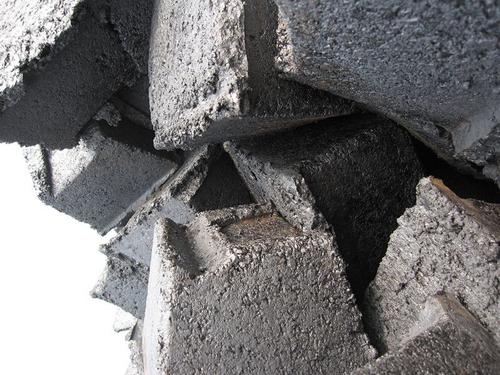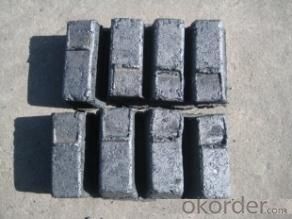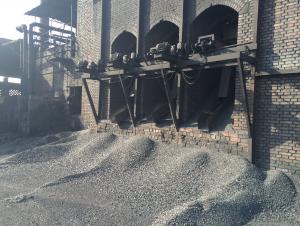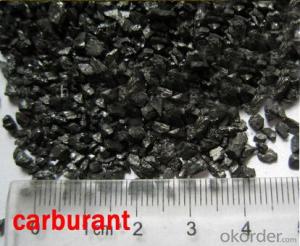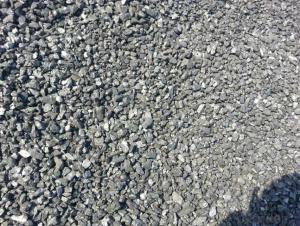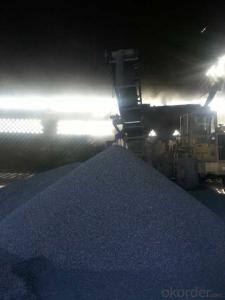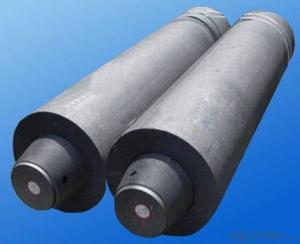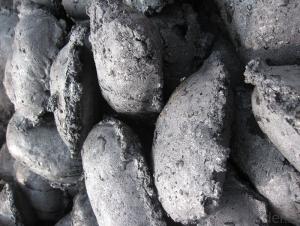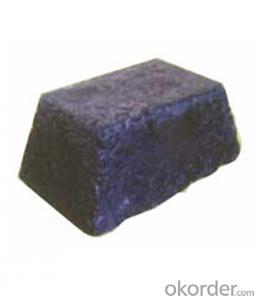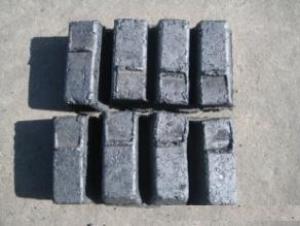Carbon Electrode Paste With Good And Stable Quality
- Loading Port:
- Lianyungang
- Payment Terms:
- TT or LC
- Min Order Qty:
- 20 m.t.
- Supply Capability:
- 800 m.t./month
OKorder Service Pledge
OKorder Financial Service
You Might Also Like
Spcifications
1for ferroalloy,calcium carbide manufacture
2HS 3801300000,YB/T5212-1996,ISO9001:2008
Product Description
Carbon Electrode Paste is a self-baking electrode used for ferroally production. Electrode Paste is added to the top of the electrode column in either cylindrical or briquette form. As the paste moves down the electrode column the temperature increase causes the paste to melt and subsequently bake forming a block of electrically conductive carbon. Electrode Paste is essentially a mix of Electrically Calcined Anthracite (ECA) or Calcined Petroleum Coke (CPC) with Coal Tar Pitch.
Carbon Electrode Paste Specification:
| PARAMETER UNIT GUARANTEE VALUE | ||||||
| Ash.( % ) | 4.0 max | 5.0 max | 6.0 max | 7.0 max | 9.0 max | 11.0 max |
| V.M (%) | 12.0-15.5 | 12.0-15.5 | 12.0-15.5 | 9.5-13.5 | 11.5-15.5 | 11.5-15.5 |
| Compress Strength. | 18.0 min | 17.0 min | 15.7 min | 19.6 min | 19.6 min | 19.6 min |
| Specific Resistance | 65 max | 68 max | 75 max | 80 max | 90 max | 90 max |
| Bulk Density | 1.38 min | 1.38 min | 1.38 min | 1.38 min | 1.38 min | 1.38 min |
Package:
In MT jumbo bag or as buyer's request
Picture:

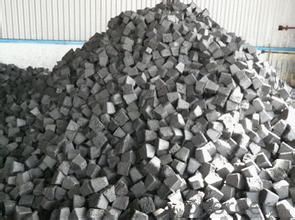
- Q: What are the environmental impacts of carbon emissions?
- Carbon emissions have a wide range of significant environmental consequences. One of the most urgent issues is their contribution to climate change. Carbon dioxide (CO2) is a greenhouse gas that traps heat in the Earth's atmosphere, causing global temperatures to rise. This temperature increase has extensive effects, including the melting of polar ice caps, rising sea levels, and more frequent and severe extreme weather events like hurricanes, droughts, and floods. Another environmental consequence of carbon emissions is ocean acidification. When CO2 is released into the atmosphere, a portion of it dissolves into the oceans and forms carbonic acid. This acidification disrupts the ocean's pH balance, which is crucial for the survival of marine life. It has a negative impact on the growth and development of coral reefs, shellfish, and other organisms that rely on calcium carbonate to create their shells or skeletons. Moreover, carbon emissions contribute to air pollution. The burning of fossil fuels not only releases CO2 but also other pollutants like nitrogen oxides (NOx), sulfur oxides (SOx), and particulate matter. These pollutants have harmful effects on air quality, leading to respiratory problems, cardiovascular diseases, and other health issues for humans and animals. Additionally, they contribute to the formation of smog and haze, reducing visibility and further deteriorating air quality. Carbon emissions also indirectly affect ecosystems. Changes in climate patterns can disrupt ecosystems and impact the distribution and behavior of various species. This can result in alterations in bird migration patterns, the timing of plant flowering, and the availability of food sources. These disruptions can have cascading effects on entire ecosystems, potentially leading to the extinction of certain species or the invasion of non-native species. Finally, carbon emissions contribute to the depletion of natural resources. Extracting and burning fossil fuels for energy production not only release carbon dioxide but also necessitate the destruction of habitats and ecosystems. This includes activities like coal mining, oil drilling, and deforestation for palm oil plantations or grazing lands. These actions result in the loss of biodiversity, habitat destruction, and soil erosion, further aggravating environmental degradation. In conclusion, the environmental impacts of carbon emissions are varied and extensive. They encompass climate change, ocean acidification, air pollution, disruption of ecosystems, and the depletion of natural resources. Addressing these impacts requires a collective effort to reduce carbon emissions and transition towards cleaner and more sustainable energy sources.
- Q: Why carbon 14 can be used to measure the age of matter?
- How to use the half-life of C-14 measurement of a substance to the age due to its half-life of 5730 years, and the carbon is one of the organic elements in biological survival time, the need to breathe, in which 14 carbon content is fairly constant, creatures die will stop breathing, the body began to reduce carbon 14 people through. Lean a antique 14 carbon content, to estimate the approximate age, this process is known as carbon dating. The study found that cosmic rays from space continuous bombardment of atmosphere, this will make the bombardment of carbon atoms in the atmosphere to form part of the ordinary radioactive carbon atoms.
- Q: What is the chemical symbol for carbon?
- The chemical symbol for carbon is C.
- Q: How can individuals reduce their carbon footprint?
- Individuals can reduce their carbon footprint by adopting sustainable lifestyle choices such as conserving energy, using public transportation or carpooling, eating a plant-based diet, reducing waste, and supporting renewable energy sources. Additionally, individuals can also make a difference by planting trees, supporting eco-friendly products, and spreading awareness about climate change.
- Q: How does carbon affect the formation of cyclones?
- Carbon dioxide (CO2) and other greenhouse gases, primarily emitted through human activities, contribute to the warming of the Earth's atmosphere. This increase in temperature impacts the formation and intensity of cyclones. Warmer sea surface temperatures provide more heat and moisture, fueling the development and strengthening of cyclones. Additionally, higher levels of carbon dioxide may lead to changes in atmospheric circulation patterns, potentially affecting the location and frequency of cyclone formation.
- Q: What are the effects of carbon emissions on the stability of mountains?
- The stability of mountains is significantly impacted by carbon emissions, leading to various negative consequences. One of the primary effects is the accelerated melting of glaciers and ice caps, caused by global warming resulting from carbon emissions. Rising temperatures cause the ice and snow that hold mountains together to melt, resulting in increased instability. This melting can lead to more frequent and larger avalanches, landslides, and rockfalls, posing a significant threat to human settlements and ecosystems in mountainous areas. Another consequence of carbon emissions on mountain stability is the alteration of precipitation patterns. As the climate changes, rainfall becomes more unpredictable, resulting in a higher frequency of intense rainfall events. This increased rainfall can cause soil erosion and weaken the stability of mountain slopes. The combination of increased erosion and weakened slopes can lead to landslides and other mass movements, further destabilizing mountains. Furthermore, carbon emissions contribute to the acidification of rainwater, which can have detrimental effects on mountain stability. Acid rain erodes rocks and soil, making them more susceptible to weathering processes. This weakening of the geological structure increases the likelihood of landslides and rockfalls. Lastly, carbon emissions also impact mountain stability through their influence on ecosystems and biodiversity in mountainous regions. Climate change caused by carbon emissions can lead to shifts in ecosystems and biodiversity, affecting the stability and resilience of mountain ecosystems, as well as altering vegetation cover patterns. The loss of vegetation cover, for example, further increases the susceptibility of slopes to erosion and landslides. In conclusion, carbon emissions have a range of negative effects on mountain stability. From accelerated glacier melting to altered precipitation patterns, acid rain, and shifts in ecosystems, these emissions pose a significant threat to the geological and ecological stability of mountains. It is crucial to reduce carbon emissions and address climate change to mitigate these effects and preserve the stability of mountain regions.
- Q: Paint paint fluorocarbon paint which expensive?
- Teflon (Tie Fulong) coating is a kind of high performance coating is the one and only, with heat resistance, chemical inertness and excellent insulation stability and low friction, the comprehensive advantages with other coatings can not compete, the flexibility makes it can be used in almost all the shape and size of the products.Fluorocarbon paint is a kind of coating with fluorine resin as its main film forming material. It is also called fluorocarbon paint, fluorine coating and fluorine resin coating. In a variety of coating, fluorocarbon resin coatings due to the introduction of fluorine element electronegativity, fluorocarbon bond energy, has the good performance. Weather resistance, heat resistance, low temperature resistance, chemical resistance, but also has a unique non sticky and low friction.
- Q: How does carbon impact the fertility of soil?
- Carbon plays a crucial role in the fertility of soil as it is the foundation of organic matter, which is vital for soil health and productivity. When carbon-rich organic matter, such as decaying plant and animal residues, is added to the soil, it helps improve its structure, nutrient-holding capacity, and water retention. This, in turn, enhances the soil's ability to support plant growth and sustain microbial activity. Organic matter serves as a source of carbon for soil microorganisms, fungi, and bacteria, which decompose it and release nutrients for plants. This decomposition process, known as mineralization, releases essential macronutrients (nitrogen, phosphorus, and potassium) and micronutrients into the soil, making them available for plant uptake. Additionally, carbon in organic matter helps bind soil particles together, improving soil structure and preventing erosion. Moreover, carbon improves the soil's water-holding capacity, reducing the risk of drought stress for plants. It acts as a sponge, absorbing and retaining moisture, which helps to sustain plant growth during dry periods. Carbon also promotes the development of a healthy and diverse soil microbial community, including beneficial bacteria and fungi. These microorganisms enhance nutrient cycling, disease suppression, and plant nutrient uptake, further contributing to soil fertility. However, excessive carbon inputs, such as from excessive organic matter addition or improper land management practices, can have negative effects on soil fertility. An imbalance in carbon availability can lead to nitrogen immobilization, where soil microorganisms consume nitrogen for their own growth, depriving plants of this essential nutrient. Additionally, high carbon content can create anaerobic conditions, reducing the availability of oxygen for plant roots and beneficial soil organisms. In summary, carbon is essential for maintaining soil fertility as it improves soil structure, nutrient availability, water retention, and microbial activity. However, it is crucial to maintain a balanced carbon-to-nitrogen ratio and adopt sustainable land management practices to ensure the optimal fertility of soil.
- Q: How does carbon dioxide affect the acidity of rainwater?
- The presence of carbon dioxide in rainwater has an impact on its acidity due to its contribution to the creation of carbonic acid. When carbon dioxide dissolves in rainwater, it engages in a reaction with water molecules, resulting in the formation of carbonic acid. This reaction causes an elevation in the concentration of hydrogen ions (H+) within the water, ultimately leading to a decrease in pH and the production of acidic rainwater. Although the carbonic acid generated from carbon dioxide is classified as a weak acid, it still possesses the ability to reduce the pH level of rainwater, rendering it more acidic than usual. This heightened acidity can result in harmful consequences for the environment, such as the destruction of plant and animal life, the corrosion of buildings and infrastructure, and the disruption of aquatic ecosystems.
- Q: What are the main factors that affect the strength of carbon fibers?
- The main factors affecting the strength of carbon fibers arePAN precursorPreoxidationcarbonizationGraphitizationsurface treatmentCoilingcarbon fibre
Send your message to us
Carbon Electrode Paste With Good And Stable Quality
- Loading Port:
- Lianyungang
- Payment Terms:
- TT or LC
- Min Order Qty:
- 20 m.t.
- Supply Capability:
- 800 m.t./month
OKorder Service Pledge
OKorder Financial Service
Similar products
Hot products
Hot Searches

